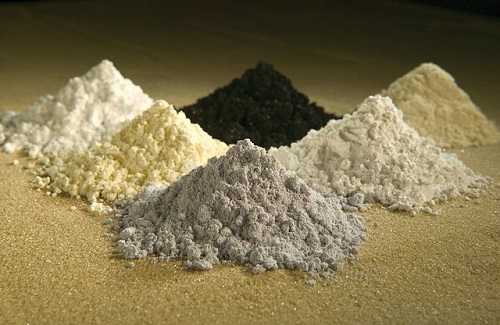Difference Between Lanthanides and Actinides
Elements are grouped into blocks and columns depending on their chemical properties. Elements with similarity in chemical composition and properties are placed within proximal columns or similar blocks. The f block, located at the bottom-most part of the Periodic Table of elements are composed of lanthanides and actinides. Common to these elements are partially filled or fully occupied f shell. They are called the “inner transition series”.
Lanthanides
Johann Galodin discovered lanthanides in 1794 when he was studying a black mineral called galodonite. Lanthanides are composed of elements between Barium to Hafnium and are generally designated as “rare earth metals”. These metals are silvery-white and abundant within the earth’s crust, with the lighter ones being more abundant. Majority of lanthanide reserves can be found in China and come in ionic ores from China’s southern provinces. Principal sources are Bastnasite (Ln FCO3), Monazite (Ln,Th)PO4 and Xenotime (Y,Ln) PO4. After extraction for principal sources, lanthanides are separated from other impurities through chemical separations, fractional crystallization, ion-exchange methods and solvent extraction. Commercially, they are used to produce superconductors, car parts and magnets. They are generally non-toxic and are not fully absorbed by the human body.
Electronic configuration
Generally, lanthanides are trivalent, with a few exceptions. 4f electrons lie interior to outer trivalent electrons. Because of its stable structure, once the compound is formed, it does not take part in any chemical bonding, making its separation process challenging. The 4f electron configuration confers the magnetic and optical behaviors of the lanthanide elements. This is the reason why it can be utilized in cathode-ray tubes. Other valence configurations for lanthanides are quadrivalent and divalent configurations. Quadrivalent lanthanides are cerium, praseodymium and terbium. Divalent lanthanides are samarium, europium and ytterbium.
Chemical Properties
Lanthanides are differentiated with how they react with air through the process of oxidation. Heavy lanthanides such as gadolinium, scandium and yttrium react slower than lighter lanthanides. There is a structural difference with the oxide product formed from lanthanides. Heavy lanthanides form the cubic modification, middle lanthanides form the monoclinic phase and light lanthanides for a hexagonal oxide structure. Because of this, light lanthanides should be stored in an inert gas atmosphere to prevent it from rapid oxidation.
Complex formation
Lanthanide ions have high charges, which supposedly favors the formation of complexes. However, individual ions have a large size compared with other transition metals. Because of this, they do not form complexes readily. In water solutions, water is a stronger ligand than amine; hence complexes with amines are not formed. Some stable complexes can be formed with CO, CN and organometallic group. The stability of each complex is indirectly proportional to the ionic radii of the lanthanide ion.
Actinides
Actinides are radioactive chemical elements that occupy the f block of the periodic table of elements. There are 15 elements in this group, from actinium to lawrencium (atomic number 89-103). Most of these elements are man-made. Because of its radioactivity, popular elements of this group, uranium and plutonium had been used for explosive warfare as atomic weapons. These are toxic chemicals that emit rays that produce cancer and tissue destruction. Once absorbed, they migrate to the bone marrow and interfere with the marrow’s function to produce blood. Because of their radioactivity, their electronic levels are less understood compared to lanthanides.
Chemical Properties
Actinides have multiple oxidation states. Trivalent actinides are actinium, uranium through einsteinium. They are crystal-like and are similar to lanthanides. Quadrivalent actinides are thorium, protactinium, uranium, neptunium, plutonium and berkelium. These freely react in aqueous solutions, unlike lanthanides. Compared to lanthanides, actinides have a pentavalent, hexavalent and heptavalent oxidation states. This permits formation of higher oxidation states through the removal of peripherally located electrons in the 5f configuration.
Complex formation
Actinides are highly radioactive and have a strong propensity to form complex reactions. Because of its unstable isotopes, some actinides are formed naturally by radioactive decay. These are actinium, thorium, protactinium and uranium. In these decaying processes, toxic rays. Actinides are capable of nuclear fission, releasing massive amounts of energy and extra neutrons. This nuclear reaction is the vital in creating complex nuclear reactions. Actinides are readily oxidizable. Once exposed to air, they ignite making them effective explosives.
Summary
Lanthanide and Actinides lie in close proximity in the Table of Periodic Elements. They are both inner transition metals, which have significant differences. Lanthanides fill the 4f orbitals and are generally non-toxic to humans. Actinides, on the other hand, fill 5f orbitals and are highly toxic causing various diseases if accidentally consumed. Actinides have varied oxidation states ranging from divalent to heptavalent oxidation states. They are readily oxidize and ignite making them effective elements in creating atomic bombs. Lanthanides on the other hand are commercially used for car parts, superconductors and magnets. Actinides are highly radioactive and have increased propensity to undergo complex reactions. In contrast, lanthanides are have stable electronic configuration and do not readily undergo complex reactions.
- The Difference Between Imitrex and Relpax - February 18, 2017
- Difference Between Reactants and Products - November 15, 2016
- Difference Between Plants and Humans - October 13, 2016
Search DifferenceBetween.net :
1 Comment
Leave a Response
References :
[0]Cotton, S. A. (2006). Lanthanide and actinide chemistry. Chichester, England: Wiley.
[1]House, J. E. (2013). Inorganic chemistry. Amsterdam: Elsevier/Academic Press.
[2]Law, G.-L., Andolina, C. M., Xu, J., Luu, V., Rutkowski, P. X., Muller, G., … Raymond, K. N. (2012). Circularly Polarized Luminescence of Curium: A New Characterization of the 5f Actinide Complexes. Journal of the American Chemical Society, 134(37), 15545–15549. http://doi.org/10.1021/ja306354n
[3]Rare-earth element. (2016). In Encyclopædia Britannica. Retrieved from https://www.britannica.com/science/rare-earth-element
[4]Tan, J., & Chan, K. S. (2011). Understanding advanced physical inorganic chemistry: The learner's approach. Singapore: WS Education.
[5]Weller, M. T., Overton, T., Rourke, J., & Armstrong, F. (2014). Inorganic Chemistry. Oxford: Oxford University Press.
[6]https://en.wikipedia.org/wiki/Lanthanide


lanthanide contractions have not been done clearly